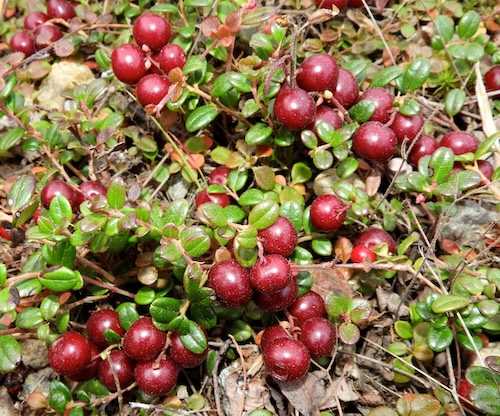Alaska Berry Futures unveils third booklet
Amy Loeffler
907-474-7933
April 23, 2024
The future of another hot Alaska commodity is at stake due to climate change: berries.
Researchers at the University of Alaska Fairbanks have developed informational booklets to help individuals and communities continue to have successful berry harvests even as the Arctic and its weather patterns change.
The Alaska Berry Futures Project promotes understanding and sharing of the impacts of climate change on northern berry species and recently expanded its berry booklet series to include a third species, the lowbush cranberry. The series has previously published guides for the cloudberry and blueberry.

Low-bush cranberries ripen in September 2019 in the Fairbanks area.
“Although we have a ton of scientific papers about how these plants are being affected, that information is not reaching the community members who need it most. The booklets are an attempt to change that,” said Christa Mulder, professor of plant ecology at the University of Alaska Fairbanks.
The booklets don’t just talk about what is likely to happen to the berry populations; they also provide ways that people can take action to ensure they will have access to the fruit.
“The ability to collect berries is an important aspect of a subsistence diet that Alaska Native and other rural communities count on, especially if they are not part of a road system,” said Mulder. “And we know that berry populations are being affected by climate change.”
Lowbush cranberries are considered true superfoods. Their anthocyanin — a natural red, blue and purple pigment — gives them the highest levels of antioxidants among 16 berry species tested in Interior and Southcentral Alaska.
Mulder said early spring warmups can harm lowbush cranberries when temperatures drop again and damage new flower buds or even kill shoots on the shrub.
Another threat to lowbush cranberries is shrub expansion into tundra areas.
“These are tundra plants, and willows and alders are expanding into their habitat,” she said. “The taller willow and alder shrubs reduce the access to light the lowbush cranberry plants have.”
But there could be an upside. Warmer winters with more snowfall may lead to an increase in berry production in Interior Alaska and the North Slope regions, said Mulder.
The publications draw on extensive research and discussions with concerned Alaskans.
The booklets provide information about the biology of each berry species. They include illustrations and information about potential climate change impacts and research gaps.
For more information about the Alaska Berry Futures Project and to access the berry booklets, please visit Alaska Berry Futures.
ADDITIONAL CONTACT: Christa Mulder, cpmulder@alaska.edu
184-24


